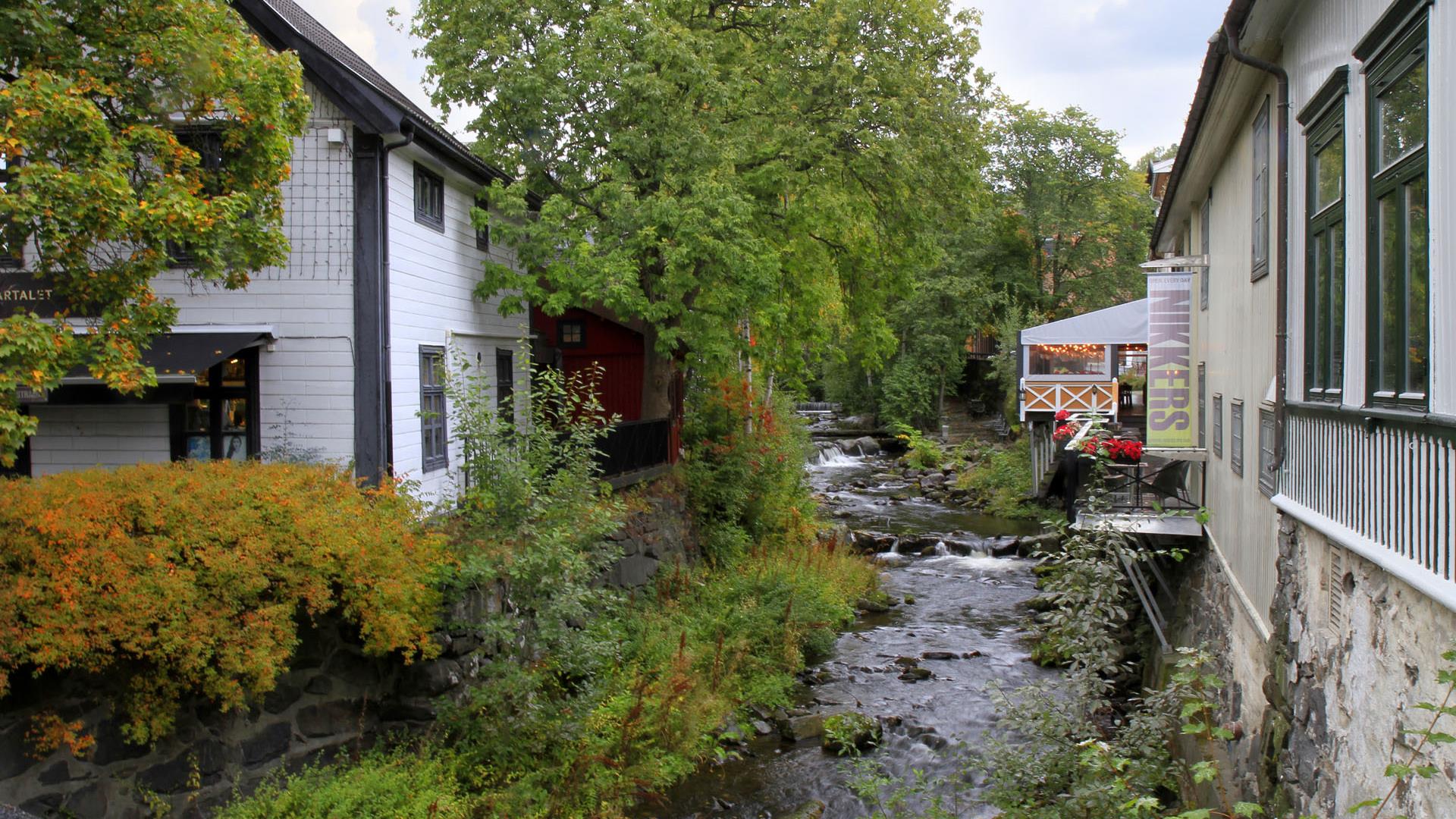About
TODAY the Mesna river is primarily of historical interest rather than practical importance for the population of Lillehammer. However, in 1827, when the first steps were taken to establish the status of a township round Hammer Farm, things were different. It was precisely this river with its inexplicable name that decided the authorities in Christiania to found a township at the north end of the Mjøsa lake instead of in places later seen as ’competitors’, Gjøvik, Hamar and Kapp.
WATERPOWER WAS OF MOST IMPORTANCE: A large catchment area ensured a secure and plentiful water supply while the drop of some 350 metres provided much power to drive water wheels and later turbines, for mills along the river. In due course a varied industry sprang up - for the time being....
NOW, most of the water runs in a tunnel from Kroken, through the underground electricity works, past Gudbrandsdalens Uldvarefabrikk and down to the Mjøsa. We can only imagine the past power and might of the river on those few days of the year when the river is allowed to flow in its original channel in order to flush away rubbish lying there.
WE BEGIN OUR TOUR where the Mesna river runs into the Lågen delta. Today, shopping is the predominant activity here on Strandtorget, a large shopping centre with over 50 shops. Started in 1990 using renovated industrial buildings, Strandtorget is constantly expanding with new stores moving into the centre or around it.
FROM THE BEGINNING of the 19th.century there was industry here. First a crushing mill providing crushed rock for the glass industry at Vingrom. Then, from 1901, The Norwegian Metal Rolling Mill (Norske Metallvalseverk) , later to become a woodpulp factory which later still became the Mesna cardboard factory. This was the town’s largest industrial workplace with a workforce of some 400 employees until it had to close in 1980.
WE CAN STILL SEE a few remains of the dams which transformed what had been an island, Morterud island, into an industrial area. The southern bed of the river is now filled in, but in the 19th.century a row of small and some larger factories lined the river banks. Driving belts and cables went from water wheels up to the main shafts of the manufacturing plants.
GUDBRANDSDALS ULDVAREFABRIKK, founded in 1887, is the town’s last industry of any size. It produces cloth for upholstery and national costumes and guards well its high reputation and traditions. Further up the river, past the Kirkegate bridge (built in 1955) are only some remnants of previous industries: Lillehammer Aktirmølle (a joint shareholders mill) has become a hotel. G.Larsen’s world renowned pipe factory is shut down long since, while the foundation walls of the old Brufoss Mill became a popular summer restaurant – Terrassen – for a while... Large concerns with premises above (east of) Storgata have been given a new lease of life.The Mesna Bruk factory which manufactured various steel products since 1814, has become a shopping centre for small businesses. The factory itself ended up at Strandtorget for a while. Lillehammer brewery and distillery, the town’s largest taxpayer since the mid 19th.century was rebuilt as «Kobberslåttet» (the copper palace) when the Olympic Games of 1994 needed premises. Today these buildings comprise flats and a whole lot of offices, mainly in the field of economics and insurance. New blocks of apartments have been erected both here and on the north bank of the river, while parts of the old, architecturally interesting facades have been preserved.
A long way into the mountains lies the underground Mesna Power Station known as ’Elverket’ with an annual production of 150 million kilowatt hours. You can see the original power station building. Lillehammer’s first electricity power station was built as early as 1894. It was the third of its kind in Norway.
’HELVETESHØLEN’ is a place you must not miss as you make your way up the river. This is a wild piece of ’vestlandsnatur’ (west coast nature) which impressed tourists in the days when the river was allowed to flow freely. You must still tread carefully here. The town’s citizens took their plunge bath under this waterfall in the second half of the 19th.Century. At that time indoor plumbing and water supply was still a far off dream.
To the right of the Fosseveien (Waterfall Way) you can get a glimpse of the facade of a bunker, a reminder of the fact that the occupying german army was controlled from here right until those fateful days in 1945. At that time nobody knew whether the highest commanding officers would fight to the last or hand themselves over.
SO WE ARRIVE at the bathing pool by Stampesletta. Here were mills that tore up and crushed rags making them into ’vadmel’, a course woollen cloth, or bark was crushed and used in the curing of hides. From the Finna bridge, fetched from Vågå in 1937, we can follow the path created especially for tourists by the town’s welfare association more than 100 years ago. At that time the Mesna river threw itself wildly and unhindered over the cliffs and rapids and was a great tourist attraction.
OUR HERITAGE PATH ENDS at the beautiful Collett bridge. This gets its name from the ’Mesna painter’ Frederik Collett, the artist who, more than any other, created the idea of Lillehammer as an artists’ town. From here we can also see the houses at Svarga, the distinctive home of Marcello Haugen. He was a man of nationwide fame, known for his clear-sightedness, mysticism and work as a nature healer. To this day there are many who still remember him as the most clairvoyant norwegian of all time.
.png)
.png)




















